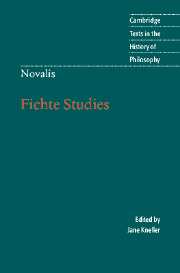Book contents
- Frontmatter
- Contents
- Preface
- Introduction
- Chronology
- Further reading
- Note on the text
- Fichte Studies
- Group I 1–210 (fall to early winter, 1795)
- Group II 211–287 (winter, 1795 to February, 1796)
- Group III 288–372 (February–March, 1796)
- Group IV 373–552 (March to early summer, 1796)
- Group V 553–568 (summer, 1796)
- Group VI 569–667 (summer to fall, 1796)
- Index
- Cambridge texts in the history of philosophy
Group I - 1–210 (fall to early winter, 1795)
Published online by Cambridge University Press: 05 June 2012
- Frontmatter
- Contents
- Preface
- Introduction
- Chronology
- Further reading
- Note on the text
- Fichte Studies
- Group I 1–210 (fall to early winter, 1795)
- Group II 211–287 (winter, 1795 to February, 1796)
- Group III 288–372 (February–March, 1796)
- Group IV 373–552 (March to early summer, 1796)
- Group V 553–568 (summer, 1796)
- Group VI 569–667 (summer to fall, 1796)
- Index
- Cambridge texts in the history of philosophy
Summary
Remarks
1. The proposition a is a contains nothing but a positing, differentiating and combining. It is a philosophical parallelism. In order to make a more distinct, A is divided (analyzed). “Is” is presented as universal content, “a” as determinate form. The essence of identity can only be presented in an illusory proposition [Scheinsatz]. We abandon the identical in order to present it. Either this occurs only illusorily – and we are brought by the imagination to believe it – what occurs, already is – naturally through imaginary separation and unification – Or we represent it through its “not-being” [what it is not], through a “not-identical” [what is not identical to it] – a sign – [using] a determined thing for an isomorphic determining thing. This isomorphic determining thing must actually determine the communicated sign in a completely unmediated way, through just the same movements as the I, freely and yet still like the I. Taste and genius. The former [taste], if it is determined through a medium, a representation, of my act of producing the sign or simply of my intention, my meaning. The latter [genius], if it is produced immediately, without this medium, the representation of my causality – like the I. The former is mere taste, the latter is the taste of genius.
The proposition: If A then A, contains this [same thing]. The rest is explained by the category of relation.
- Type
- Chapter
- Information
- Novalis: Fichte Studies , pp. 3 - 64Publisher: Cambridge University PressPrint publication year: 2003

